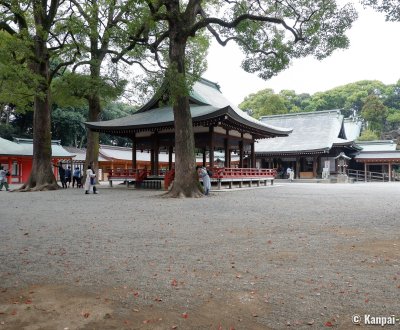Hikawa-jinja
Saitama’s Great Shrine
Hikawa-jinja is an ancient Shinto shrine located in Saitama City’s Omiya ward, in the north of Tokyo. The large pavilions of this influential regional complex are scattered in a quiet forested area.
Hikawa-jinja, also known in its full name as Musashi Ichinomiya Hikawa, is one of the oldest and most influential Shinto shrines of the Kanto area. Its credentials include:
- Being the 1rst ichi-no-miya sanctuary of the former Musashi province at the time of its construction;
- Until 1946, it was one of the 67 first rank imperial shrines, also called kanpei-taisha; and,
- Head shrine of all of the country’s Hikawa shrines, including Kawagoe’s and central Tokyo’s Akasaka’s.
Consequently, the 3 kamis enshrined here are some of the most important deities of the Shinto cult, namely:
- Susanoo no Mikoto, Amaterasu’s brother and god of storms that ruled over the oceans;
- Kushinada-hime no Mikoto, Susanoo’s wife, considered the goddess of rice;
- Okuninushi, the king of Izumo, who wedded Suseri-hime, Susanoo’s daughter. Regarded as the country’s founder, he is mainly worshiped as a god of agriculture and medicine.
According to the legend, Susanoo arrived on Earth in the Izumo Province where he received his wife after freeing her from the curse of the dragon Yamata no Orochi. The 8-headed monster terrorized Kushinada-hime’s family by devouring one of her sisters every year. Susanoo made it drink quantities of nihonshu 🍶, vanquished it and cut it into pieces.

An imperial alley in a straight line
Located about 2 kilometers from Omiya station, the site is accessible walking a long, beautiful, and pedestrian only alley called Hikawa Sando, leading to its main entrance. Protected by huge trees, 3 high torii ⛩️ gates succeed each other solemnly. This majestic pathways help visitors feel the historical importance of Hikawa-jinja, even if it is not located in the capital but in a quiet neighborhood of Saitamai City.
Inside the complex’s grounds, visitors are first welcomed by a forested area sheltering various small size pavilions, especially shrines to Inari, Tenman, Mitake, Matsuo and Monkyaku. Then, the path opens on a pond, whose central islet is home to a Munakata shrine and connected by bridges.

A large main plaza
The main plaza offers another sight and dimension compared to the minimalist and bucolic introduction, signaled by the impressive Romon vermilion gate and its enclosure wall. The heart of Hikawa-jinja shrine is large, dotted with Shinto buildings and trees that are as ancient as sacred.
The buildings are placed along the same line, and visitors at the threshold of the Romon gate face the following pavilions:
- Maiden, a stage for ritual dances;
- Haiden, a hall for the worshipers to pray; and,
- Honden, the main pavilion where are enshrined the kami deities.
The side is occupied by the shrine’s shop to purchase items for divine protection and lucky charms such as ofuda talismans, omamori amulets or the usual ema votive plates. Tourists can also buy these items as a souvenir blessed by the gods.

Hikawa-jinja’s grounds are usually quiet, besides the few important events attracting more people than usual. Among them are the New Year’s Day (oshogatsu in Japanese), the national holidays period Golden Week and the festivals Reisei on August 1rst, Jinkosai, on August 2nd, and lastly the Honsai on December 10th. More than 2 million people visit the shrine every year.
In spring and on a good weather day, we recommend continue the walk to Omiya Park and its many beautiful blooming sakura 🌸 trees, complemented by children’s playgrounds and a zoo.

